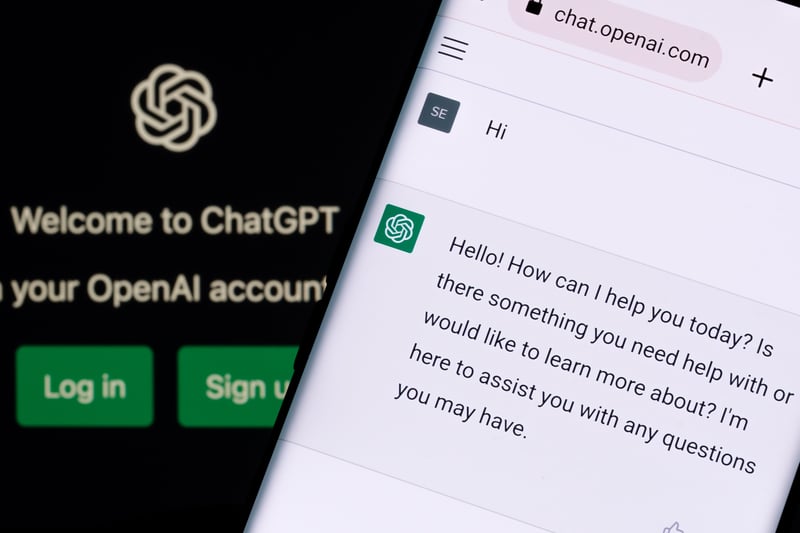
Artificial intelligence and machine learning applications have been increasingly adopted across the many areas of operations for organizations across the public and private sectors. However, programs like ChatGPT are opening new doors for AI adoption and operational automation.
Uses for ChatGPT in business are just starting to be explored. And unlike previous uses of AI as part of something like the Internet of Things, which is mostly present in machines utilized in manufacturing and logistics, programs like ChatGPT have shown the potential to revolutionize multiple “back office” functions.
From customer service to content management and more, generative AI is taking the business world by storm. So just what is it? Is AI more of a tool to be utilized by a human workforce instead of a replacement for them? How easily can it be incorporated into your existing enterprise content management infrastructure?
Before digging into the ways ChatGPT corporate use is advancing, it is important to understand just what it is. ChatGPT made a big splash when it became publicly available in 2022.
ChatGPT is what’s called “generative AI.” It is a large language model (LLM) that takes in prompts from users to generate realistic, human-like writing. This writing can be produced in a more conversational tone or in the formal style that a business has developed for official communications or just about anything in between.
An LLM is “trained” on vast amounts of text to guide it in building an understanding of the quirks and foibles of written language. That understanding goes beyond simply learning the strict rules of grammar that a human might learn in junior high. The initial public release of ChatGPT was fueled by fiction, nonfiction, technical and scientific literature, textbooks, news copy, and just about any other kind of text found on the internet. This means the model is able to draw on a huge reservoir of acquired knowledge to respond to user prompts.
Often those prompts include the topic of the piece of writing desired as well as a preferred style of writing. When a prompt is entered, the program draws on relevant information and corresponding stylistic writings to generate the desired response.
Because of the versatility of topics and styles available as well as the speed at which the program can generate content, forward thinkers immediately started brainstorming new uses for ChatGPT in business.
With an understanding of the basics of how it works, we can begin to explore the ChatGPT application in business. How does generative AI contribute to business processes and workflows? What areas can be most effectively augmented with a program like ChatGPT?
One of the first areas that generative AI can augment is customer service. Many companies are already using automated chat functions, commonly called chatbots. But "classical" chatbots (now anything older than 3 years) are limited to utilizing standardized responses to specific queries or keywords. With a large language model AI, a customer service chatbot can respond to queries beyond standardized phrases. It can better respond to a customer’s concerns, even when that customer does not necessarily know the exact terminology for the issue they are facing.
Additionally, that chatbot can carry on a conversation with the customer that simulates what a human would type into a chat window. This helps the customer feel heard while protecting your team members from those customers that would abuse customer service representatives with inappropriate requests and advances—a problem that just about everyone who has worked in a customer service setting has encountered.
Using ChatGPT in business is not limited to outward facing functions, though. There are many internal tasks that can benefit from properly deployed generative AI.
ChatGPT can be used to automate several data and content management functions thanks to its ability to understand how language is used in documents. This means that important information such as values in an invoice can be automatically identified and transferred to the relevant applications for processing.
And that’s just the tip of the iceberg. Usage of ChatGPT for companies in wildly different industries is evolving constantly. From coding to analysis to summarizing reports to assistance with search engine optimization, companies are testing ChatGPT’s capabilities every day.

With the wide range of functions and tasks that ChatGPT can facilitate, the question of how to best incorporate this large language model generative AI into your enterprise data and content management system arises.
Microsoft has actually already begun to incorporate ChatGPT into their Azure platform. This means that those using Azure to implement cloud solutions and develop customized applications unique to their organizations’ needs may already have a fully integrated AI ready to assist them.
This is an extremely valuable integration. It allows you to feed your private information into a secure, private ChatGPT model so that your internal servers and cloud storage can be searched and utilized with the same speed and accuracy that the public version of ChatGPT has demonstrated on the internet at large.
Essentially, by combining AI with cognitive search functionality, Azure allows for “retrieval augmented generation.” This means that your ChatGPT can combine searches through proprietary information as well as publicly available data to generate in-context, relevant responses.
The Azure integration allows you to store the knowledge and insights gained from your usage of the AI model outside of the actual ChatGPT programming—ensuring that you retain your information to use as you see fit.
So even if you use ChatGPT to dig through both public and private information, your private information stays private.
The potential upsides for ChatGPT in business are numerous, but as with any developing technology, anyone seeking to make use of it must be aware of the risks involved.
For example, ChatGPT was fed massive amounts of information before it debuted publicly, but that does not mean that it has all the information in the world. Some of the information the program relies on could be out of date, depending on when the programmers last pushed an update.
Additionally, safeguards against misinformation are still being developed. There are some safeguards in place, but misinformation can still make its way into use in ChatGPT. And if you feed your AI private data that is incorrect, the program will have no way to know.
Finally, all current AI models have the ability to simply make the wrong connections when determining links between relevant data or language. When this happens, the model may respond with inaccurate assertions or conclusions that are nonsensical or altogether inaccurate. The common term for this is a "hallucination" and is something that all AI users must be on guard for.
That’s the biggest thing to be aware of when you look at ChatGPT corporate use: current generation AI tools are like highly skilled but impressionable children - they are susceptible to bad data skewing their perceptions and can occasionally make connections that are simply incorrect.
With the need to ensure that accurate information is fed into ChatGPT, the impact on your team members will largely be in the form of a change in responsibilities.
Instead of spending half their week entering values into spreadsheets and running processing macros, your team members will instead be able to focus on higher level tasks—the kinds of tasks that require critical thinking and creativity.
ChatGPT in business allows time-consuming tasks to be completed in a fraction of the time, which in turn allows your human workforce to focus on the interpretation of data and recognizing those times when the information put forth by your AI may need to be double checked.
With Microsoft's release of its evolution of ChatGPT in the form of Copilot and Copilot for M365, you want to be sure you understand how to use it optimally. TEAM IM’s experience with enterprise content management, cloud services, development platforms, and AI/ML makes us an exceptionally valuable resource.
While ChatGPT in business may be new, our experts have a deep understanding of how AI, including large language models, works in enterprise systems. The best way to take advantage of the emerging benefits of generative AI, such as Copilot or ChatGPT, while avoiding potential pitfalls is to reach out to TEAM IM today.
These Stories on AI
121 Washington Ave N, 4th Floor
Minneapolis, MN 55401
L2, 1 Post Office Square
Wellington 6011
119 Willoughby Road
Crows Nest NSW 2065
No Comments Yet
Let us know what you think